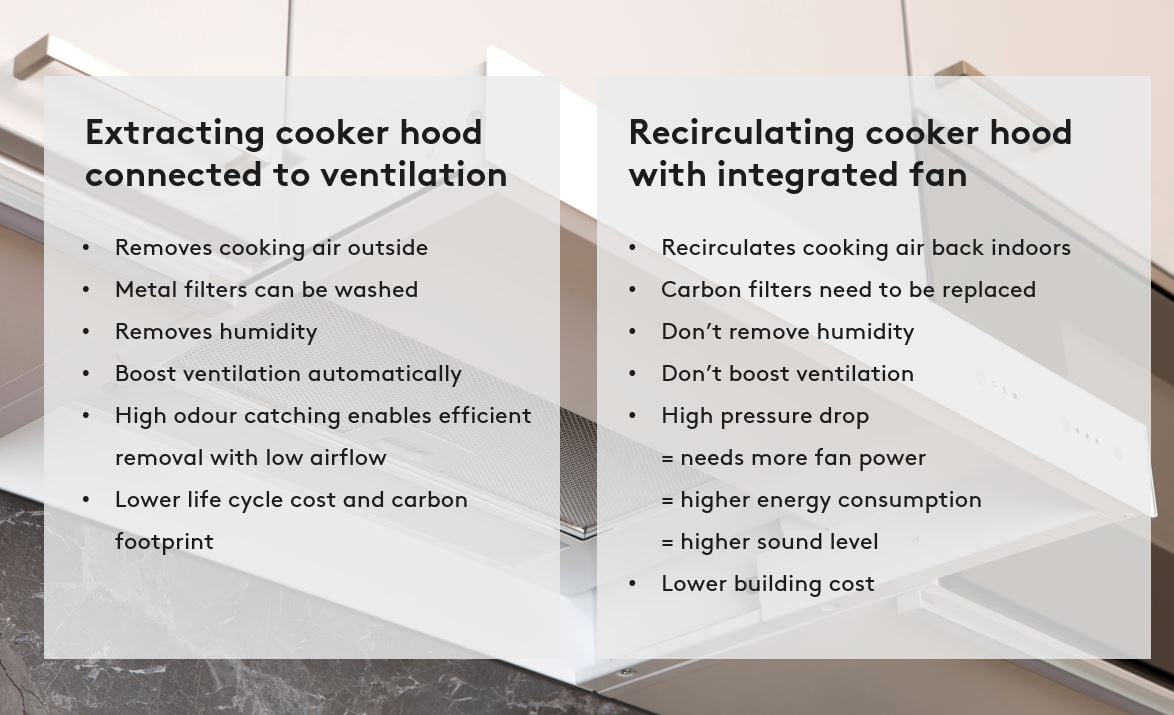It's said that good food and a warm kitchen are what makes a house a home. For friends and families the kitchen is often a gathering place where delicious food and happy memories are made. But when designing indoor climate systems for residential buildings it can be the most problematic room when it comes to air quality – the cooking is unfortunately also a significant source of air pollutants. So how can we design indoor climate systems that strike a balance between great air quality and an enjoyable cooking experience? Let’s have a closer look at cooker hoods.
The purpose of a cooker hood is simple: remove odours, excessive humidity and heat and prevent them from spreading around the apartment. However, there are different alternatives available and selecting the right hood has a big role in the overall indoor environment. A good cooker hood is designed with air quality as the highest priority.
The odour catching capacity tells how much fumes the cooker hood can actually remove. Cooker hoods that have a high capacity remove more odours with lower air flow. This equals better air quality with less fan power, less energy consumption and lower sound level. Therefore you should always prefer a cooker hood with a good odour catching capacity tested according to EN standards.
Extract or recirculate?
The main question is: do you wish to extract cooking odours outside or clean and recirculate them back in the apartment?
Recirculating cooker hoods have integrated motor/fan and they use special carbon filters to clean the air. These hoods don’t require separate ducting to the roof and therefore this is a cheaper system to build. Furthermore, because the air is not removed outside there is no need to compensate the airflow.
However, even if the carbon filters can remove most particles from the air, the cleaning result is never 100 % and it depends on how often filters are replaced. High quality filters can be rather expensive and may need to be replaced several times a year depending on the usage. Carbon filters typically create higher pressure drop and therefore they need more fan power which increases electricity consumption and sound levels inside the apartment.
Another downside is that they don’t remove any humidity or excessive heat and they don't bring any new fresh air in the apartment. The actual ventilation system needs to be boosted separately to guarantee efficient odor removal and good air quality.
Extracting cooker hoods remove cooking fumes outside the building. They also remove excessive heat and humidity unlike the recirculating kitchen hoods. Extracting cooker hoods are typically connected to a separate roof fan or a ventilation system. When connected to a ventilation system there is no need for a separate fan or ducting for the kitchen hood. Fan in the roof is the most silent option, but fan inside the ventilation unit creates also much less sound in the kitchen than fan inside the cooker hood.
However, when cooking fumes are removed outside the extracted air needs to be compensated. This means we should bring in new fresh air to replace the dirty air flown outside. When cooker hood is connected to ventilation system this happens automatically and more fresh air flows indoors during cooking.

Conclusions
Recirculating kitchen hood with carbon filters may be cheaper to build, but due to higher energy consumption and expensive replacement filters they tend to have higher life cycle cost and larger carbon footprint and they don’t provide the same level of indoor air quality as the extracting cooker hoods.
To sum it all up, if kitchen is the heart of the home, ventilation system and kitchen hood are the lungs that breath out the bad air and breath in the fresh air. Selecting a high quality cooker hood that works together with the ventilation system enables a great indoor environment to residential buildings.
For more information about different cooker hoods and ventilation systems please visit Swegon.com





-Aug-16-2023-12-30-41-3641-PM.png?width=75&name=MicrosoftTeams-image%20(3)-Aug-16-2023-12-30-41-3641-PM.png)






.jpg?width=75&name=sigvardsson_220628_0008_small_webb%20(1).jpg)












.jpg?width=75&name=magnus%20andersson_550x550%20(1).jpg)











-4.png?width=75&name=MicrosoftTeams-image%20(3)-4.png)











